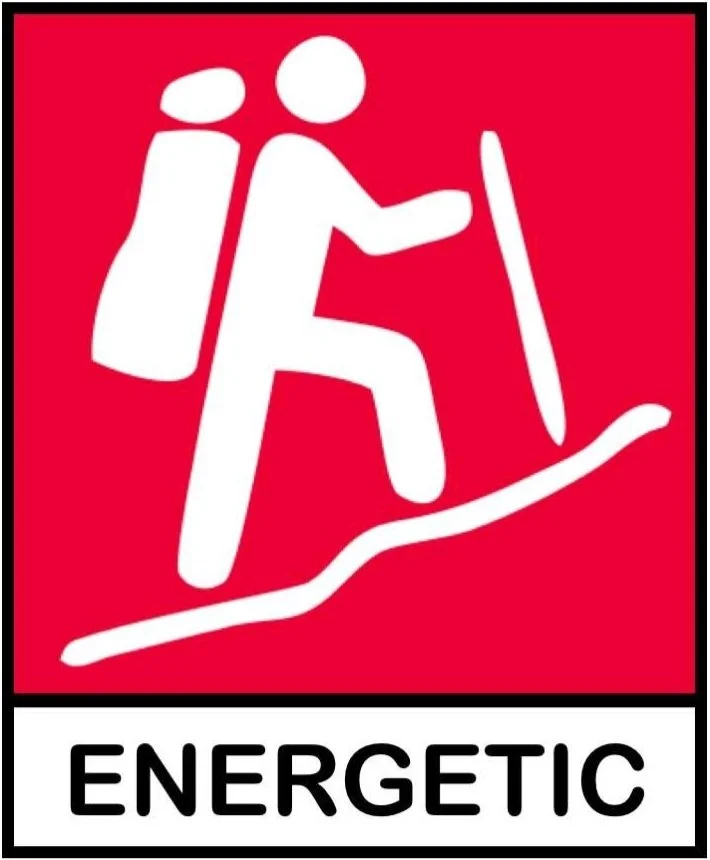
Hike Grades
Leisurely
Daily Distance: 6-10 km (4-5 miles)
Ascents: Under 300m (under 1000 ft)
Terrain: Good paths and gentle pace
Our easier walking grades offer hikes at a relaxed pace, making them suitable for individuals with average fitness levels. You will enjoy outings on well-maintained paths with minimal slopes.
These walks typically follow popular and frequently used trails and do not present significant challenges or steep gradients.
For our leisurely hikes, we recommend wearing good-quality walking or trail shoes. Look for shoes with a thick, moulded rubber sole that provides good traction and a low heel, as these features are generally sufficient for these hikes.
Relaxed
Daily Distance: 8-13 km (6-8 miles)
Ascents: Under 300m (under 1000 ft)
Terrain: Good paths and gentle pace
Our easier walking grades, where hikes are gentler, with only an average fitness required. You’ll enjoy days out on gentle slopes, distinct coastal and valley tracks and primarily defined paths, with no special difficulties.
The terrain is easy with walks from 8-13 km (5-8 miles), average 4-5 hours walking a day with some sightseeing and inclines generally under 1000ft (300m). This is not to say that the terrain is not wet or muddy!
Good quality walking shoes or trail shoes with a thick, moulded rubber sole, good tread, and a low heel are recommended for our relaxed hikes. These hikes are likely to require only these shoes.
Moderate
Daily Distance: 15-20 km (9-13 miles)
Ascents: 250-600m (800 & 2000 ft)
Terrain: Moderate, mainly paths
These hikes involve slightly strenuous walking on easier to moderate slopes, tracks, and paths, including hills and accessible mountains, which may sometimes be rough or wet. They typically take place in low-level mountains, moorland, or undulating countryside.
The terrain features peaks up to 750 meters (2,500 feet) and inclines between 250 and 600 meters (800 and 2,000 feet). Daily walking lasts about 5 to 6 hours, rarely exceeding 6 or 7.
We recommend lightweight walking boots with good tread and ankle support for these hikes. Depending on ground conditions, experienced walkers with strong ankles may find high-quality trail shoes suitable.
Energetic
Daily Distance: 15-25 km (10-15 miles)
Ascents: 500-1000m (1500 & 3000 ft)
Terrain: Moderate to Hard, stronger pace
If you love hiking in the mountains, moorlands, or hills, these challenging hikes will allow you to climb higher peaks and navigate tougher paths. Prepare for exhilarating experiences on trails near steep drops, with some sections featuring light scree and rocky terrain.
These hikes typically cover between 13 and 19 kilometres (8 and 12 miles) daily, with ascents of 500 to 1000 metres (1500 to 3000 feet) and approximately 7 hours of walking daily.
Sturdy walking boots with good ankle support and a deep tread are essential for our Energetic Hikes. Waterproof uppers are recommended for winter walks, while lightweight boots may suffice for some summer hikes.
Challenging
Daily Distance: 8-32+ km (11-20+ miles)
Ascents: 800-1400m (2500 & 4500 ft)
Terrain: Hard, often with no visible path
These strenuous hikes involve high peaks and multiple ascents. To enjoy this level of hiking, you should be an experienced hiker and fit.
These Challenging grade walks are classified based on distances covered, and other criteria, such as gradients, amount of ascent and descent, and the nature of the surface. Some walks may be over pathless ground and include short scrambling sections.
'Scrambling' means that hands are needed to move along a rocky terrain trail. It is intermediate between walking and rock climbing. Scrambling does not always mean 'vertigo-inducing'!
The terrain is hard; you should anticipate walking between 7 and 8 hours daily. There are more challenging sections and occasional scrambling, and possible areas of high exposure should be anticipated. You should also expect to walk over open ground away from paths.
Proper walking boots with a moulded sole and deep tread, good ankle support, and waterproof uppers are recommended for our challenging hikes. Our hike leaders reserve the right to decline members they consider ill-equipped.
Technical
Daily Distance: Distance isn’t the deciding factor
Ascents: 800-1400m (2500 & 4500 ft)
Terrain: Very Hard
Hikes with high peaks, multiple ascents and difficult arêtes in some exposed areas. These are very strenuous and exciting hikes where participants should be experienced and fit, as they would require large amounts of strenuous climbs and scrambles to enjoy these levels of hikes.
'Scrambling' means that hands are needed to move along a rocky terrain trail. It is an intermediate between walking and rock climbing.
Scrambling does not always mean 'vertigo-inducing'! Technical skills and equipment might be required, such as ropes, ice axes, and crampons.






